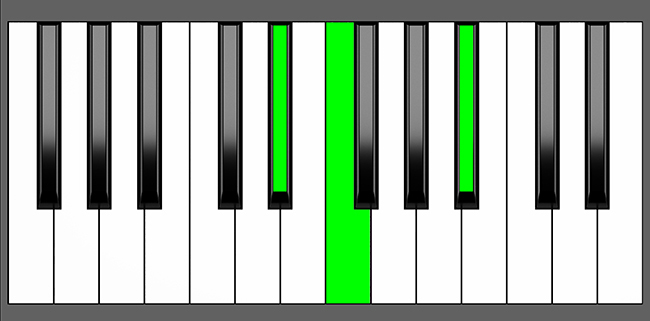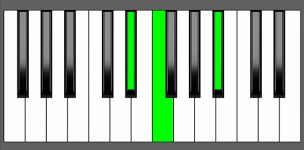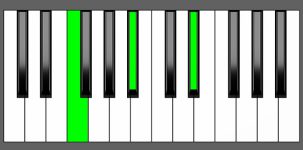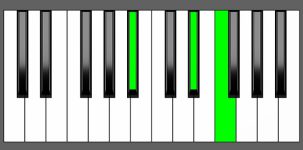Piano Diagram of Ebsus2 in Root Position

The Ebsus2 chord consists of three notes: Eb, F, and Bb. This chord is known as a suspended second chord, where the third note of the chord is replaced by a major second. To play the Ebsus2 chord on a piano, simply replace the third note of an Eb major chord (G) with the major second (F). Keep reading to get a better grip on the music theory behind this chord.
Structure of Ebsus2
Notes |
|---|
| Eb, F, Bb |
Intervals |
|---|
| R, 2, 5 |
Fingers Position
Left Hand |
|---|
| 3, 2, 1
4, 2, 1 |
Right Hand |
|---|
| 1, 2, 5
1, 2, 4 |
Ebsus2 Chord Inversions
The Ebsus2 chord has a total of 2 inversions:
| Root Position: | Eb | F | Bb |
| 1st Inversion: | F | Bb | Eb |
| 2nd Inversion: | Bb | Eb | F |
Piano Keyboard Diagrams
Ebsus2 Chord Equivalencies
An interesting detail about sus2 chords is that their 2nd inversion results in a sus4 chord. To clarify, when the 5th note of a sus2 chord becomes the root note, it transforms into a sus4 chord.
2nd Inversion of Ebsus2 = Bbsus4
For instance, if we take the Ebsus2 chord with the notes Eb, F, and Bb and rearrange them so that Bb becomes the root note, we end up with a Bbsus4 chord with the notes Bb, Eb, and F. Therefore, the 2nd inversion of Ebsus2 is equivalent to Bbsus4.
Music Theory and Harmony of Ebsus2
What are Suspended Chords?
In suspended chords, the third note is replaced by either a major second or a perfect fourth. The resulting chords are called suspended second (sus2) or suspended fourth (sus4) chords, respectively. These chords create a unique and sometimes unresolved sound that can add tension and interest to a musical composition.
Suspended chords have a distinctive sound that sets them apart from major and minor chords. They are so-called because they temporarily suspend the listener’s expectation of hearing a major or minor stable chord. Instead, they feature a perfect fourth or major second interval in place of the third. Due to their “neutral nature”, suspended chords can sometimes be used as substitutes for both, major and minor chords.
Building the Ebsus2 Chord: Different Approaches
Starting from the Eb major Scale
To build a sus2 chord, you can use the major scale as a guide and combine a root note, a major 2nd interval, and a perfect 5th interval. For example, to form an Ebsus2 chord, you can begin with the Eb major scale, which includes the notes Eb, F, G, Ab, Bb, C, and D.


To create an Ebsus2 chord, apply the formula R, 2, 5 in the following manner:
- Begin with the Root note, which is Eb.
- Select the major 2nd interval, which is F, and add it to the chord.
- Finally, add the 5th interval, which is Bb.
By following this simple formula, you can create a sus2 chord from any major scale.
by Combining Intervals
One method to create a suspended 2nd chord is by combining two specific intervals – a major 2nd, and a perfect 4th.
2 + 4 = sus2 Chords
To illustrate, let’s use the Ebsus2 chord as an example. By examining the intervals between the notes, we can see that Eb-F forms a major 2nd interval (a whole tone), and F-Bb creates a perfect 4th interval.
How to Use Ebsus2 in a Chord Progression
Suspended second (sus2) chords are neither major nor minor, making them a great option to create tension and suspense before resolving to major and minor chords.
The tables below show the harmonization of major and relative natural minor scales for keys that include Eb major (including Eb7 chords) and Eb minor chords in various positions and different harmonic roles.
Ebsus2 as Substitute of Eb Maj Chords
on Major Scales
| Major Scales | I | ii | iii | IV | V | vi | vii |
|---|---|---|---|---|---|---|---|
| Eb | Eb Maj7 ⇒ Ebsus2 | F min7 | G min7 | Ab Maj7 | Bb Maj7 | C min7 | Dm7b5 |
| Bb | Bb Maj7 | C min7 | D min7 | Eb Maj7 ⇒ Ebsus2 | F Maj7 | G min7 | Am7b5 |
| Ab | Ab Maj7 | Bb min7 | C min7 | Db Maj7 | Eb7 ⇒ Ebsus2 | F min7 | Gm7b5 |
- Tonic chord in Eb Major
- Subdominant chord in Bb Major
- Dominant chord in Ab Major
on Natural minor Scales
| Minor Scales | i | ii | III | iv | v | VI | VII |
|---|---|---|---|---|---|---|---|
| C | C min7 | Dm7b5 | Eb Maj7 ⇒ Ebsus2 | F min7 | G min7 | Ab Maj7 | Bb7 |
| G | G min7 | Am7b5 | Bb Maj7 | C min7 | D min7 | Eb Maj7 ⇒ Ebsus2 | F7 |
| F | F min7 | Gm7b5 | Ab Maj7 | Bb min7 | C min7 | Db Maj7 | Eb7 ⇒ Ebsus2 |
- Mediant chord in C minor
- Submediant chord in G minor
- Leading tone chord in F minor
Ebsus2 as Substitute of Eb min Chords
In the key of B Major and Ab minor, the note F can clash with the E and F# notes that are present in those keys. While this doesn’t prevent you from using the Ebsus2 chord in those positions, it’s important to be aware that it can create a strong dissonance with the melody or other elements of the composition.
on Major Scales
| Major Scales | I | ii | iii | IV | V | vi | vii |
|---|---|---|---|---|---|---|---|
| Db | Db Maj7 | Eb min7 ⇒ Ebsus2 | F min7 | Gb Maj7 | Ab7 | Bb min7 | Cm7b5 |
| Cb = B | B Maj7 | C# min7 | D# min7 ⇒ D#sus2 = Ebsus2 | E Maj7 | F#7 | G# min7 | Bbm7b5 |
| Gb = F# | F# Maj7 | G# min7 | A# min7 | B Maj7 | C#7 | D# min7 ⇒ D#sus2 = Ebsus2 | E#m7b5 |
- Supertonic chord in Db Major
- Non Diatonic Mediant chord in B Major as D#sus2
- Submediant chord in F# Major as D#sus2
on Natural minor Scales
| Minor Scales | i | ii | III | iv | v | VI | VII |
|---|---|---|---|---|---|---|---|
| Eb | Eb min7 ⇒ Ebsus2 | Fm7b5 | Gb Maj7 | Ab min7 | Bb min7 | Cb Maj7 | Db7 |
| Bb | Bb min7 | Cm7b5 | Db Maj7 | Eb min7 ⇒ Ebsus2 | F min7 | Gb Maj7 | Ab7 |
| Ab | Ab min7 | Bbm7b5 | Cb Maj7 | Db min7 | Eb min7 ⇒ Ebsus2 | Fb Maj7 | Gb7 |
- Tonic chord in Eb minor
- Subdominant chord in Bb minor
- Non Diatonic Dominant chord in Ab minor
Ebsus2 Chord Function in Major and Minor Keys
Understanding Scale Degrees
When creating chords from a scale, each note in the scale is assigned a degree, which reflects its position in the scale. In the diatonic major scale, there are seven degrees, and each degree has a unique role in the overall harmony of the scale.
- The first degree of the scale is called the Tonic, and it serves as the foundation for the scale. It provides a stable tonal center and is often referred to as the “home base” of the music.
- The second degree of the scale is called the Supertonic. It’s typically used as a passing note between the tonic and other scale degrees, and it adds a sense of movement to the melody or harmony.
- The third degree of the scale is called the Mediant. It’s located halfway between the tonic and dominant notes and helps to establish whether the scale is major or minor.
- The fourth degree of the scale is called the Subdominant. It’s often used as a complementary harmony to the dominant and adds a sense of tension and resolution to the music.
- The fifth degree of the scale is called the Dominant. It generates tension and a sense of expectation, and it’s typically resolved by returning to the tonic.
- The sixth degree of the scale is called the Submediant. It’s often utilized as a transition between the dominant and tonic, and it provides a sense of stability and restfulness to the music.
- The seventh degree of the scale is called the Leading tone. It’s located one half step below the tonic and produces a strong sense of tension and a desire to resolve to the tonic. It’s often used to create a sense of resolution and finality in the melody or harmony.
Ebsus2 in Eb Major
The Ebsus2 chord can be used along with the Eb Maj7 chord (or any other kind of Eb major chord) on the first degree to create movement in a chord progression. The Ebsus2 chord can suspend the Eb Major chord or the subsequent chord.
| I | ii | iii | IV | V | vi | vii |
| Eb Maj7 | F min7 | G min7 | Ab Maj7 | Bb7 | C min7 | Dm7b5 |
Ebsus2 Chord Progressions as I degree
ii V I
| ii | V | I |
| F min7 | Bb7 | Ebsus2 | Eb Maj7 |
I IV V
| I | IV | V |
| Ebsus2 | Eb Maj7 | Ab Maj7 | Bb7 |
I V vi IV
| I | V | vi | IV |
| Ebsus2 | Eb Maj7 | Bb7 | C min7 | Ab Maj7 |
I IV vi V
| I | IV | vi | V |
| Ebsus2 | Eb Maj7 | Ab Maj7 | C min7 | Bb7 |
Ebsus2 in Bb Major
Let’s find out how the Ebsus2 chord sounds in the Bb major scale as a substitution or variation of the Eb Maj7 chord on the IV degree.
| I | ii | iii | IV | V | vi | vii |
| Bb Maj7 | C min7 | D min7 | Eb Maj7 | F7 | G min7 | Am7b5 |
Ebsus2 Chord Progressions as IV degree
I IV V
| I | IV | V |
| Bb Maj7 | Ebsus2 | Eb Maj7 | F7 |
I V vi IV
| I | V | vi | IV |
| Bb Maj7 | F7 | G min7 | Ebsus2 | Eb Maj7 |
I IV vi V
| I | IV | vi | V |
| Bb Maj7 | Ebsus2 | Eb Maj7 | G min7 | F7 |
Ebsus2 in Ab Major
In the key of Ab Major, the fifth degree features an Eb7 chord. Adding an Ebsus2 chord can create tension and expectation, leading to a resolution on the dominant chord.
| I | ii | iii | IV | V | vi | vii |
| Ab Maj7 | Bb min7 | C min7 | Db Maj7 | Eb7 | F min7 | Gm7b5 |
Ebsus2 as V degree – Chord Progressions
ii V I
| ii | V | I |
| Bb min7 | Ebsus2 | Eb7 | Ab Maj7 |
I IV V
| I | IV | V |
| Ab Maj7 | Db Maj7 | Ebsus2 | Eb7 |
I V vi IV
| I | V | vi | IV |
| Ab Maj7 | Ebsus2 | Eb7 | F min7 | Db Maj7 |
I IV vi V
| I | IV | vi | V |
| Ab Maj7 | Db Maj7 | F min7 | Ebsus2 | Eb7 |
I IV ii V iii vi ii V
| I | IV | ii | V | iii | vi | ii | V |
| Ab Maj7 | Db Maj7 | Bb min7 | Ebsus2 | Eb7 | C min7 | F min7 | Bb min7 | Ebsus2 | Eb7 |
Ebsus2 in C Minor
Try experimenting with chord progressions featuring an Eb Maj7 on the III degree of the C minor scale, and try playing an Ebsus2 before or after the Eb Maj7 to see how it sounds.
| i | ii | III | iv | v | VI | VII |
| C min7 | Dm7b5 | Eb Maj7 | F min7 | G min7 | Ab Maj7 | Bb7 |
Ebsus2 Chord Progressions as III degree
i III
| i | III |
| C min7 | Ebsus2 | Eb Maj7 |
i III VII VI
| i | III | VII | VI |
| C min7 | Ebsus2 | Eb Maj7 | Bb7 | Ab Maj7 |
i III iv v
| i | III | iv | v |
| C min7 | Ebsus2 | Eb Maj7 | F min7 | G min7 |
i III ii v
| i | III | ii | v |
| C min7 | Ebsus2 | Eb Maj7 | Dm7b5 | G min7 |
I iii vi V
| i | III | VI | iv |
| C min7 | Ebsus2 | Eb Maj7 | Ab Maj7 | F min7 |
Circle Progression
| i | iv | VII | III | VI | ii | V7 | i |
| C min7 | F min7 | Bb7 | Ebsus2 | Eb Maj7 | Ab Maj7 | Dm7b5 | G7 | C min7 |
Ebsus2 in G Minor
In the key of G minor, the VI degree chord is an Eb major chord. You can use an Ebsus2 chord as a variation or substitution of this chord. Try using the Ebsus2 chord before or after the Eb major chord in your chord progressions to add interest and variation.
| i | ii | III | iv | v | VI | VII |
| G min7 | Am7b5 | Bb Maj7 | C min7 | D min7 | Eb Maj7 | F7 |
Ebsus2 Chord Progressions as VI degree
i VI VII
| i | VI | VII |
| G min7 | Ebsus2 | Eb Maj7 | F7 |
i v VI VII
| i | v | VI | VII |
| G min7 | D min7 | Ebsus2 | Eb Maj7 | F7 |
i III VII VI
| i | III | VII | VI |
| G min7 | Bb Maj7 | F7 | Ebsus2 | Eb Maj7 |
Circle Progression
| i | iv | VII | III | VI | ii | V7 | i |
| G min7 | C min7 | F7 | Bb Maj7 | Ebsus2 | Eb Maj7 | Am7b5 | D7 | G min7 |
Ebsus2 in F Minor
Let’s explore the use of Ebsus2 as a leading tone chord in the key of F minor. As the leading tone chord, Ebsus2 can create tension and lead the listener’s ear to the tonic chord, which is F minor in this case.
| i | ii | III | iv | v | VI | VII |
| F min7 | Gm7b5 | Ab Maj7 | Bb min7 | C min7 | Db Maj7 | Eb7 |
Ebsus2 as VII degree – Chord Progressions
i VI VII
| i | V | VII |
| F min7 | C min7 | Ebsus2 | Eb7 |
i v VI VII
| i | v | VI | VII |
| F min7 | C min7 | Db Maj7 | Ebsus2 | Eb7 |
i III VII VI
| i | III | VII | VI |
| F min7 | Ab Maj7 | Ebsus2 | Eb7 | Db Maj7 |
Circle Progression
| i | iv | VII | III | VI | ii | V7 | i |
| F min7 | Bb min7 | Ebsus2 | Eb7 | Ab Maj7 | Db Maj7 | Gm7b5 | C7 | F min7 |
Ebsus2 in Db Major
In the key of Db Major, the supertonic chord is an Eb minor. However, we can use an Ebsus2 chord as a variation or substitution for the Ebm chord to add some tonal color and interest to a chord progression.
| I | ii | iii | IV | V | vi | vii |
| Db Maj7 | Eb min7 | F min7 | Gb Maj7 | Ab7 | Bb min7 | Cm7b5 |
Ebsus2 Chord Progressions as ii degree
ii V I
| ii | V | I |
| Ebsus2 | Ebm7 | Ab7 | Db Maj7 |
I IV ii V iii vi ii V
| I | IV | ii | V | iii | vi | ii | V |
| Db Maj7 | Gb Maj7 | Ebsus2 | Ebm7 | Ab7 | F min7 | Bb min7 | Ebmin7 | Ebsus2 | Ab7 |
Ebsus2 in Cb Major (Non diatonic)
Check D#sus2 in B Major
Ebsus2 in Gb Major
Check D#sus2 in F# Major
Ebsus2 in Eb Minor
When using the Ebsus2 chord in the key of Eb minor, it can be a variation of the traditional Ebm chord. It creates a more ambiguous sound due to its suspended nature, but it can be used to add tension to a chord progression.
| i | ii | III | iv | v | VI | VII |
| Eb min7 | Fm7b5 | Gb Maj7 | Ab min7 | Bb min7 | Cb Maj7 | Db7 |
Ebsus2 Chord Progressions as i degree
i VI VII
| i | VI | VII |
| Ebsus2 | Ebm7 | Cb Maj7 | Db7 |
Chromatic modulation
| i | isus2 | isus4 | i |
| Eb min
(Eb, Gb, Bb) |
Ebsus2
(Eb, F, Bb) |
Ebsus4
(Eb, Ab, Bb) |
Eb min
(Eb, Gb, Bb) |
i iv VI VII
| i | iv | VI | VII |
| Eb min | Ebsus2 | Ab min7 | Cb Maj7 | Db7 |
Ebsus2 in Bb Minor
In the Bb minor scale, the IV degree is Eb major, which can be replaced or varied by an Ebsus2 chord.
| i | ii | III | iv | v | VI | VII |
| Bb min7 | Cm7b5 | Db Maj7 | Eb min7 | F min7 | Gb Maj7 | Ab7 |
Ebsus2 Chord Progressions as iv degree
iv III VI VII
| iv | III | VI | VII |
| Ebsus2 | Ebm7 | Db Maj7 | Gb Maj7 | Ab7 |
i iv VI v
| i | iv | VI | v |
| Bb min7 | Ebsus2 | Ebm7 | Gb Maj7 | F min7 |
Ebsus2 in Ab Minor (Non Diatonic)
As an alternative or substitution for the v degree chord (Eb minor) in the key of Ab minor, you may use an Ebsus2 chord. However, note that the Ebsus2 chord is non-diatonic in this key due to the presence of F, while the Ab minor scale includes an Fb and a Gb. Therefore, it’s generally advisable to avoid using the Ebsus2 chord in this context, but don’t hesitate to experiment and see how it sounds to your liking.
| i | ii | III | iv | v | VI | VII |
| Ab min7 | Bbm7b5 | Cb Maj7 | Db min7 | Eb min7 | Fb Maj7 | Gb7 |
Ebsus2 as v degree – Chord Progressions
i iv VI v
| i | iv | VI | v |
| Ab min7 | Db min7 | Fb Maj7 | Ebsus2 | Ebm7 |
i v VI VII
| i | v | VI | VII |
| Ab min7 | Ebsus2 | Ebm7 | Fb Maj7 | Gb7 |
i VI v iv
| i | VI | v | iv |
| Ab min7 | Fb Maj7 | Ebsus2 | Ebm7 | Db min7 |
Alternative Names for Ebsus2 Chord
- Ebsus2
- Ebsus(2)
- Eb add2(no3)
- Eb add2(omit3)
- Eb Suspended 2nd
Conclusion
While the chord progressions and examples in this post offer a comprehensive overview of common uses for the Ebsus2 chord, space constraints prevent a full exploration of advanced harmony topics. These include chord progressions based on scales, modal interchange, and jazz harmony. However, readers are encouraged to continue their studies to gain a deeper understanding of the harmonic possibilities beyond the basics presented here.
I hope this post has been informative and helpful in your music theory journey. Keep exploring and creating music, and don’t forget to have some fun along the way!


